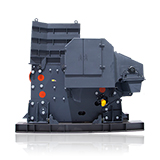Potassium Feldspar Crusher Selection: Types & Key Factors
Potassium feldspar, noted for its aluminosilicate composition, is an indispensable mineral resource. The beneficiation process aims to improve ore quality by separating valuable potassium feldspar from gangue minerals. In ore processing, crushing is the first crucial stage where ore particles are reduced to a size suitable for subsequent grinding and separation. The selection and performance of the crushing equipment directly impact the overall efficiency of the beneficiation line, product quality, and energy consumption.

Importance of Crushing in the Potassium Feldspar Beneficiation Process
The beneficiation process for potassium feldspar typically follows a series of well-defined stages: primary crushing, secondary and tertiary crushing, followed by grinding, classification, flotation, or other separation methods. Crushing equipment is responsible for breaking down the large blocks of feldspar extracted from the mine into smaller fragments that are easier to process. The effectiveness of crushing determines the efficiency of downstream separation processes, making it a key focus for process engineers in potassium feldspar plants.
Potassium feldspar crushing process flow might include:
- Primary Crushing: Large ore blocks are introduced into a jaw crusher, which reduces the feed size significantly.
- Secondary Crushing: The output from the primary stage is then fed into an impact crusher to achieve further size reduction and to attain a specific particle size distribution.
- Tertiary Crushing: For finer crushing, a cone crusher may be employed to produce a highly uniform product that is then sent to grinding mills.
- Each stage of crushing is optimized to ensure that the potassium feldspar is liberated from the gangue without excessive degradation of its crystalline structure.
Types of Potassium Feldspar Crusher Used
1. Jaw Crusher
Jaw crushers are typically utilized as primary crushers in the feldspar beneficiation process. These machines operate on the principle of compressive force, with two jaws (one fixed and one movable) that crush the ore as it is fed into the machine. Jaw crushers are recognized for their robustness, ease of operation, and ability to handle large feed sizes. They are highly efficient in reducing the size of the ore while preserving the integrity of potassium feldspar crystals.
2. Impact Crusher
Impact crushers, including both horizontal shaft impact (HSI) and vertical shaft impact (VSI) machines, are commonly applied in secondary crushing stages. Their working mechanism involves striking the ore with high-speed rotors fitted with hammers or blow bars. For potassium feldspar, impact crushers offer the advantage of producing a more uniform particle size distribution, which is beneficial for subsequent beneficiation stages. Modern impact crushers also incorporate designs that minimize over-crushing, thus preserving the desirable properties of the feldspar.

3. Cone Crusher
Cone crushers are deployed in both secondary and tertiary crushing stages. They use a rotating mantle within a concave bowl to crush ore by compressive force. The design of cone crushers allows for a higher reduction ratio and more precise control over particle size distribution. In the context of potassium feldspar beneficiation, cone crushers are advantageous when processing high-silica ores due to their ability to maintain the structural characteristics of the mineral while reducing wear on the equipment.

Factors to Consider When Choosing a Potassium Feldspar Crusher
- 1. Ore Characteristics: The hardness, abrasiveness, and moisture content of potassium feldspar influence the choice of crushing equipment. For example, a jaw crusher is preferable for the initial reduction of hard and heterogeneous ore, while an impact crusher may be chosen for its ability to produce a consistent size distribution.
- 2. Energy Consumption: Energy efficiency is a major concern in modern beneficiation plants. Advanced crusher designs now integrate smart sensors and real-time control systems that allow for the fine-tuning of operational parameters. This not only reduces energy consumption but also extends the lifespan of wear parts.
- 3. Maintenance and Reliability: Frequent downtime for maintenance can hamper production and increase operational costs. Innovations such as dual hydraulic adjustment and automated lubrication systems in modern crushers have substantially reduced maintenance times and enhanced machine reliability.
The crushing stage is a cornerstone in the potassium feldspar beneficiation process, significantly influencing the efficiency and effectiveness of ore processing. Advanced potassium feldspar crusher, including jaw, impact, and cone crushers, plays a vital role in reducing ore size while preserving the quality of the feldspar. Coupled with state-of-the-art control systems and technological innovations, modern crushing plants are more efficient, reliable, and energy-saving than ever before. These advancements not only enhance production efficiency but also support a sustainable operation, ensuring that the potassium feldspar beneficiation process remains competitive in a rapidly evolving industrial landscape.







